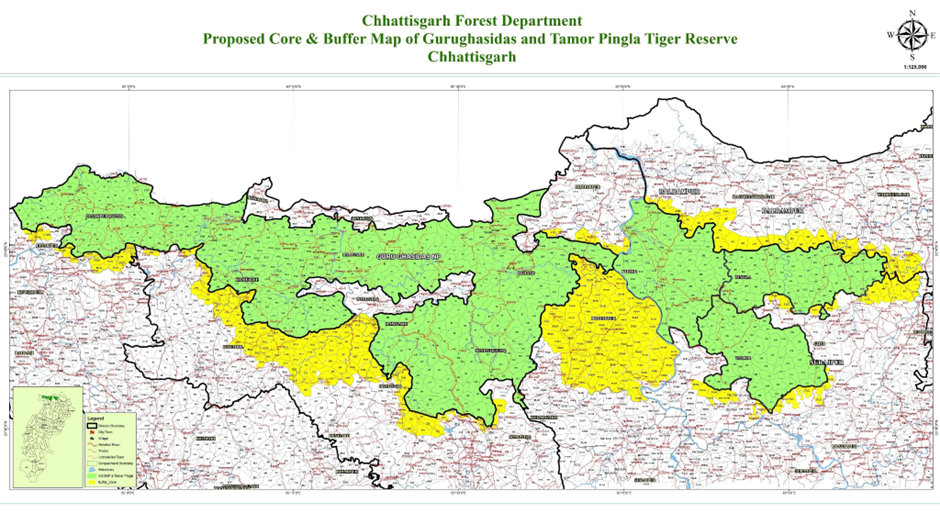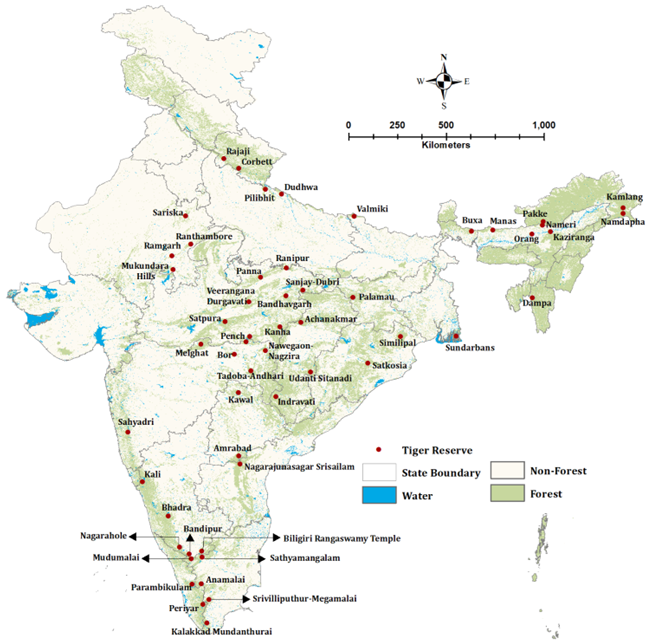- Courses
- GS Full Course 1 Year
- GS Full Course 2 Year
- GS Full Course 3 Year
- GS Full Course Till Selection
- Answer Alpha: Mains 2025 Mentorship
- MEP (Mains Enrichment Programme) Data, Facts
- Essay Target – 150+ Marks
- Online Program
- GS Recorded Course
- Polity
- Geography
- Economy
- Ancient, Medieval and Art & Culture AMAC
- Modern India, Post Independence & World History
- Environment
- Governance
- Science & Technology
- International Relations and Internal Security
- Disaster Management
- Ethics
- NCERT Current Affairs
- Indian Society and Social Issue
- NCERT- Science and Technology
- NCERT - Geography
- NCERT - Ancient History
- NCERT- World History
- NCERT Modern History
- CSAT
- 5 LAYERED ARJUNA Mentorship
- Public Administration Optional
- ABOUT US
- OUR TOPPERS
- TEST SERIES
- FREE STUDY MATERIAL
- VIDEOS
- CONTACT US
India’s 56th Newest Tiger Reserve tiger reserve: Chhattisgarh’s Guru Ghasidas-Tamor Pingla Tiger Reserve
India’s 56th Newest Tiger Reserve tiger reserve: Chhattisgarh’s Guru Ghasidas-Tamor Pingla Tiger Reserve
23-11-2024

- Earlier in November 2024, the Chhattisgarh government notified the Guru Ghasidas-Tamor Pingla Tiger Reserve as India’s 56th tiger reserve.
- This move aims to strengthen tiger conservation efforts in the state, which has seen a decline in its tiger population in recent years.
- The reserve also aligns with the state’s ambitious plans to reintroduce cheetahs — the last cheetah was spotted here in the 1940s.
- Chhattisgarh is now home to 4 Tiger Reserves.
- This makes it the 3rd largest tiger reserve in the country after Nagarjunasagar-Srisailam Tiger Reserve in Andhra Pradesh and Manas Tiger Reserve in Assam.
Key Features of the Guru Ghasidas-Tamor Pingla Tiger Reserve:
-
Geographical Area and Location:
- Size: The reserve spans an area of 2,829.387 sq km, making it the third largest tiger reserve in India.
- Location: It is spread across four districts in the northern tribal region of Sarguja in Chhattisgarh:
- Manendragarh-Chirmiri-Bharatpur (MCB)
- Korea
- Surajpur
- Balrampur
- The reserve lies between Bandhavgarh in Madhya Pradesh and Palamau in Jharkhand, and is adjacent to the Sanjay Dubri Tiger Reserve in Madhya Pradesh.
-
Biodiversity:
- Wildlife: The Guru Ghasidas-Tamor Pingla Tiger Reserve is home to a diverse range of species including:
- Tigers, elephants, sloth bears, vultures, leopards, wolves, peacocks, bison, hyenas, langurs, jackals, cobras, and more.
- Flora: The reserve has rich vegetation including species like sal, saja, kusum, and dhavda trees. The topography comprises hills, plateaus, valleys, and a river system that creates diverse habitats for wildlife.
- Wildlife: The Guru Ghasidas-Tamor Pingla Tiger Reserve is home to a diverse range of species including:
Current Tiger Population in Chhattisgarh:
- As of now, the state has a total of 30 tigers, including three sub-adults and two cubs.
- Guru Ghasidas-Tamor Pingla Tiger Reserve currently houses five to six tigers.
- However, the state’s tiger population has declined over the years, from 46 tigers in 2014 to only 17 in 2022, according to the latest National Tiger Conservation Authority (NTCA) report released in 2023.
Plans to Boost the Tiger Population:
- Tigress Relocation: To address the tiger population imbalance, the government plans to relocate tigresses from Bandhavgarh and Sanjay Dubri Tiger Reserves in Madhya Pradesh to the Guru Ghasidas-Tamor Pingla Reserve.
- Other Measures: These include:
- Establishing rapid response teams.
- Building strong relationships with local villagers.
- Developing informant-based wildlife protection systems.
- Deploying full-time guards for constant vigilance.
Conservation Efforts and Preparations:
-
Tiger Conservation Plan (TCP):
- The reserve authorities are preparing a comprehensive Tiger Conservation Plan (TCP) to address challenges and ensure the reserve becomes a sustainable tiger habitat. The TCP includes:
- Improving connectivity with MP, which has a rising tiger population.
- Developing grasslands and water bodies to increase the prey base, including translocating animals like cheetal and wild boars from other parts of the state.
- Wildlife corridor development to facilitate tiger migration and reduce human-wildlife conflict.
- The reserve authorities are preparing a comprehensive Tiger Conservation Plan (TCP) to address challenges and ensure the reserve becomes a sustainable tiger habitat. The TCP includes:
-
Human-Wildlife Conflict Mitigation:
- The reserve includes 42 sparsely populated villages.
- Authorities are working on voluntary relocation options for these residents and providing employment opportunities, especially in eco-tourism activities like tour guiding, homestays, boating, and handicrafts.
Future Plans and Challenges:
- Cheetah Reintroduction: Wildlife activists have suggested the reintroduction of cheetahs, similar to efforts in Madhya Pradesh.
- While the cheetah population is extinct in the region, conservationists are hopeful about reintroducing this species.
What is Project Tiger?
Background:
Launch of Project Tiger:
Progress and Challenges:
Current Status:
Map showing locations of Tiger Reserves in India:
|







